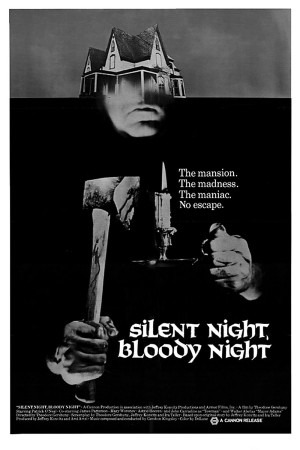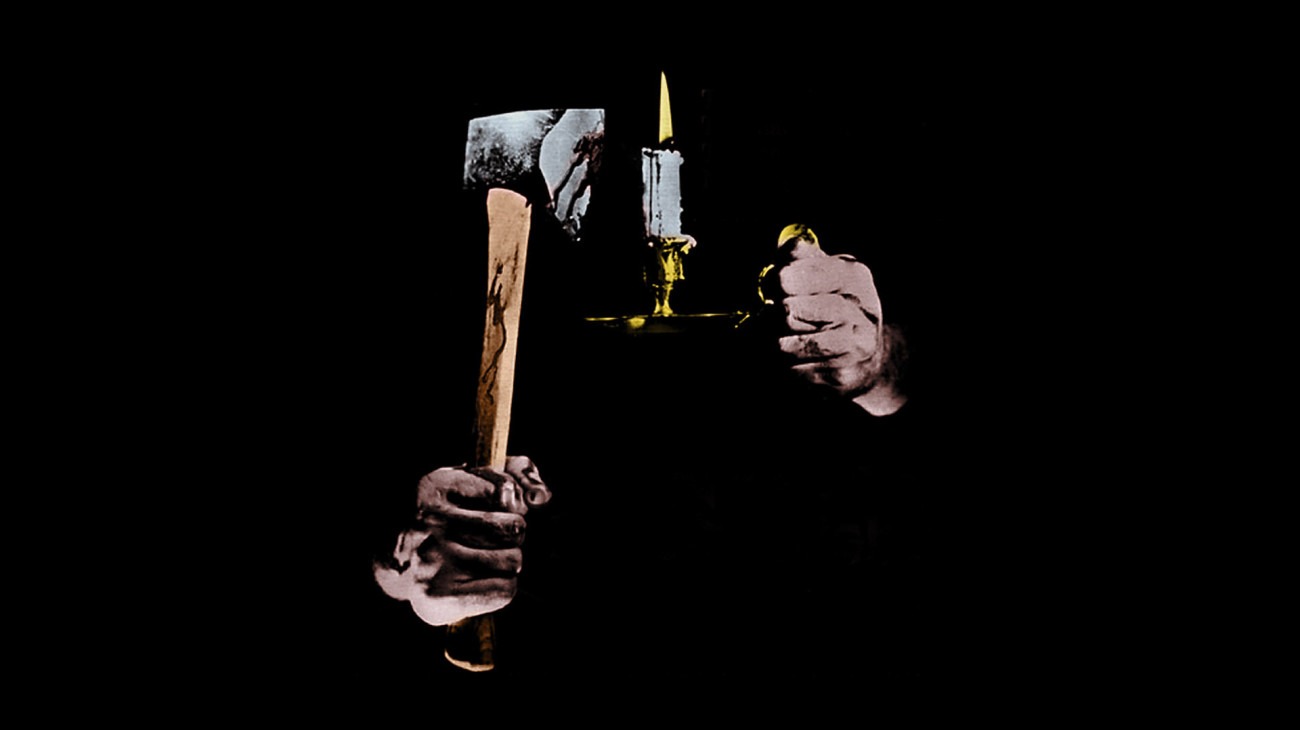
Merry Deathmas
Okay, some turns of phrase suck more than others. But every halfway decent Christmastime horror pun was taken decades ago.
Anyway, there is no single calendar day better represented in the annals of horror movies than December 25. Following up on my colossally successful and better-named Summer of Blood, I've decided to spend the next four weeks investigating the highs and lows of Yuletide horror pictures. I'm going to do something a little different than I usually do - trying to keep up with the Summer of Blood nearly ended me, and that was during the theoretically laid-back summertime. The Christmas season, of course, is where laid-back goes to die. So instead of full-on reviews, these are going to be fairly short inventories.
(I was originally planning to do this on the four Sundays of Advent, but that seemed to be in poor taste).
First up:
Silent Night, Bloody Night (1973, USA)
The creators: Director Theodore Gershuny (his third and final feature, after two forgotten exploitation flicks); co-writers Jeffrey Konvitz (later a producer on Cyborg 2 and Spy Hard) and Ira Teller (a journalist with no other film credits)
The plot: In 1971, Diane Adams (Mary Woronov, a veteran of Warhol's Factory) relates a story of what happened in "that house": first the owner, Wilfred Butler, burned to death on Christmas Eve, 1950; 20 years later, his grandson, Jeffrey Butler (James Patterson) comes back from California to sell the house to the community leaders, who are eager to tear it down. His lawyer John Carter (Patrick O'Neal) is on hand to manage the deal , bringing with his mistress Ingrid (Astrid Hereen). They spend the night in the abandoned Butler mansion, where they are killed by a gloved figure with a mask. As the town elders start to fall one by one, Diane and Jeffrey begin to uncover Wilfred Butler's many secrets, as a whispery voice claiming to be "Marianne" taunts them.
Christmas cheer: Pervasive but shallow. The story takes place in the week before Christmas, and there are many signifiers: trees, lights, snow, carols on the radio. But nothing about the plot is essentially Christmassy, in a way that it is for e.g. Gremlins. Methinks the title wagged the dog.
Type of horror: Strongly giallo-influenced murder mystery.
The good: Woronov's presence, and cameos by a few other Factory superstars in flashbacks, pushes the film into a sort of sub-Warhol place where the clunky dialogue and wooden acting seem almost like they may be choices & not incompetence. The script uses twists in a clever and unusual way, giving us info that makes us think we're ahead of the film but then running around us oh-so-smart viewers and providing a sort of "double twist." There is a use of false protagonists that recalls Psycho, only without the temporary loss of inertia that it causes in that film. The use of POV anticipates Sam Raimi. John Carradine is in the cast.
The bad: The lengthy climactic flashback takes much too long to cover far too few events. The scare scenes are invariably unscary. The film engages in the giallo tendency towards plots that stop making sense about five minutes in, without compensating with a giallo-like collection of magnificently poetic images - the cinematography is at best "competent" in the way that a third-year film school undergraduate is competent. Most characters behave arbitrarily to advance the story, particularly the romantic subplot. The audio sounds like it was recorded in a bathroom. John Carradine is in the cast.
Blood: Only one scene has any gore to speak of, although it is mostly just smearing stage blood on sheets, so as to avoid tricky wound prosthetics. The moment is shocking enough that it is believable.
Boobs: None, although one knowing tease shows a woman taking off her top, cutting a mere frame or two before we see anything.
Sex=death: The only truly bloody scene is a murder that interrupts the only sex act in the film. Coincidence?
Body count: An extraordinary 11, spread across three time periods and three or four killers.
Sign it was 1973: If the presence of Factory stars isn't enough, maybe the ratty aluminum trees everywhere are.
Pithy wrap-up: Not at all scary, but agreeably far from the mainstream, especially for its time. A bit on the experimental side for what could have been just another sleazy horror program-filler.
Anyway, there is no single calendar day better represented in the annals of horror movies than December 25. Following up on my colossally successful and better-named Summer of Blood, I've decided to spend the next four weeks investigating the highs and lows of Yuletide horror pictures. I'm going to do something a little different than I usually do - trying to keep up with the Summer of Blood nearly ended me, and that was during the theoretically laid-back summertime. The Christmas season, of course, is where laid-back goes to die. So instead of full-on reviews, these are going to be fairly short inventories.
(I was originally planning to do this on the four Sundays of Advent, but that seemed to be in poor taste).
First up:
Silent Night, Bloody Night (1973, USA)
The creators: Director Theodore Gershuny (his third and final feature, after two forgotten exploitation flicks); co-writers Jeffrey Konvitz (later a producer on Cyborg 2 and Spy Hard) and Ira Teller (a journalist with no other film credits)
The plot: In 1971, Diane Adams (Mary Woronov, a veteran of Warhol's Factory) relates a story of what happened in "that house": first the owner, Wilfred Butler, burned to death on Christmas Eve, 1950; 20 years later, his grandson, Jeffrey Butler (James Patterson) comes back from California to sell the house to the community leaders, who are eager to tear it down. His lawyer John Carter (Patrick O'Neal) is on hand to manage the deal , bringing with his mistress Ingrid (Astrid Hereen). They spend the night in the abandoned Butler mansion, where they are killed by a gloved figure with a mask. As the town elders start to fall one by one, Diane and Jeffrey begin to uncover Wilfred Butler's many secrets, as a whispery voice claiming to be "Marianne" taunts them.
Christmas cheer: Pervasive but shallow. The story takes place in the week before Christmas, and there are many signifiers: trees, lights, snow, carols on the radio. But nothing about the plot is essentially Christmassy, in a way that it is for e.g. Gremlins. Methinks the title wagged the dog.
Type of horror: Strongly giallo-influenced murder mystery.
The good: Woronov's presence, and cameos by a few other Factory superstars in flashbacks, pushes the film into a sort of sub-Warhol place where the clunky dialogue and wooden acting seem almost like they may be choices & not incompetence. The script uses twists in a clever and unusual way, giving us info that makes us think we're ahead of the film but then running around us oh-so-smart viewers and providing a sort of "double twist." There is a use of false protagonists that recalls Psycho, only without the temporary loss of inertia that it causes in that film. The use of POV anticipates Sam Raimi. John Carradine is in the cast.
The bad: The lengthy climactic flashback takes much too long to cover far too few events. The scare scenes are invariably unscary. The film engages in the giallo tendency towards plots that stop making sense about five minutes in, without compensating with a giallo-like collection of magnificently poetic images - the cinematography is at best "competent" in the way that a third-year film school undergraduate is competent. Most characters behave arbitrarily to advance the story, particularly the romantic subplot. The audio sounds like it was recorded in a bathroom. John Carradine is in the cast.
Blood: Only one scene has any gore to speak of, although it is mostly just smearing stage blood on sheets, so as to avoid tricky wound prosthetics. The moment is shocking enough that it is believable.
Boobs: None, although one knowing tease shows a woman taking off her top, cutting a mere frame or two before we see anything.
Sex=death: The only truly bloody scene is a murder that interrupts the only sex act in the film. Coincidence?
Body count: An extraordinary 11, spread across three time periods and three or four killers.
Sign it was 1973: If the presence of Factory stars isn't enough, maybe the ratty aluminum trees everywhere are.
Pithy wrap-up: Not at all scary, but agreeably far from the mainstream, especially for its time. A bit on the experimental side for what could have been just another sleazy horror program-filler.
Categories: exploitation films, horror, merry deathmas, mysteries, tis the season






